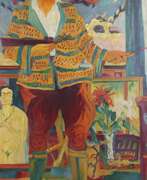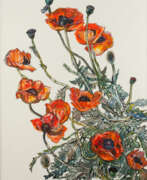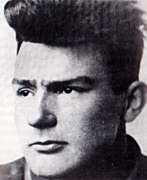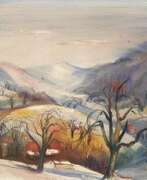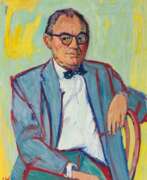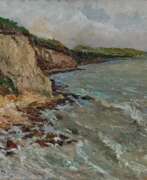Mountain landscape Expressionism


Virginia Berresford is an American artist and printmaker.
Virginia Berresford studied with George Bridgman at the Art Students' League and in Paris with Amedee Ozenfan from 1925 to 1930. Berresford was known for her landscape paintings with strong composition and use of colour as well as attention to detail.
In the 1950s she opened an art gallery in Edgartown, Martha's Vineyard. Her work is included in the permanent collections of the Whitney Museum of American Art, the Detroit Art Institute and the Dallas Museum of Art.


Herbert Brandl is one of the most famous Austrian expressionist artists. He achieved success through his large-format works.
Landscape as a theme was always dominant in his work, where pictorial abstraction and subjectivity alternate. Since the beginning of the new millennium, Brandl's passion for the monumentality of mountain landscapes has become increasingly evident. Using various formats and techniques, the artist has reinterpreted the theme of mountains, playing with expressive gestures, abstract colour spaces and massive forms.
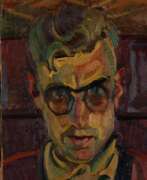

Heinrich Danioth was a Swiss painter and poet.
Some of Danioth’s most notable works include the murals, "Tellsprung" and "Rütlischwur", on the walls of the Tellspielhaus, an Altdorf theatre, in 1927.
He painted the mural “Fundamentum” in 1936. It is currently located at the Federal Letter Museum, one of three historical museums in Schwyz, Switzerland.
Another notable work is the large-format mural "Föhnwacht", created on behalf of the Federal Art Commission.
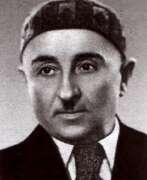

Gabriel Mikaelovich Gyurdzhyan (Armenian Գաբրիել Գյուրջյան) was an Armenian painter. People's Artist of the Armenian SSR (1945), art historian, teacher. One of the founders of the Soviet Armenian fine arts.
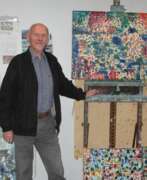

Zacharias Heinesen is a Faroese painter. He is the son of the writer and artist William Heinesen.
His works include oil paintings, watercolour paintings, drawings, woodcuts, lithographs and paper collages.
His paintings were featured on a series of stamps in June 2001.
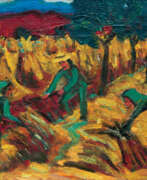

Walter Helbig is a German and Swiss painter, graphic designer and woodcarver. He works in Dresden on church paintings. Helbig participated in the founding and first exhibition of the "Neue Secession" in Berlin in 1910. Helbig took part in the first Modern Bund exhibition in 1911 in Lucerne and in the second, larger one, at the Kunsthaus in Zurich. In 1914, some painters from the vanished “Modern Bund”, including Helbig, took part in the first Dada exhibition at the Galerie Coray in Zurich. Helbig is also represented in the third Dada exhibition and contributes to the magazine Der Zeltweg 8 but does not participate in the activities of the Dadaists. In 1919, he was one of the signatories of the “manifesto of radical artists” 9 in Zurich, and joined the “November group” in Berlin. Helbig lived in Zurich from 1916 to 1924 and in 1916 became a member of the GSMBA (Society of Swiss Painters, Sculptors and Architects), in which he regularly participated. Since the First World War, his artistic work has turned to religious and mythical subjects. In 1924 Helbig, like many other artists, moved to Ascona due to the low cost of living and founded the movement Der Große Bär. During this time, Helbig painted landscapes, still lifes and portraits. Walter Helbig had his first major solo exhibition in Zurich in 1948 and became a member of the Association of German Artists in 1952. After the Second World War, he also followed the artistic currents of the time, abstract expressionism and experimented with informal art in the 1960s.
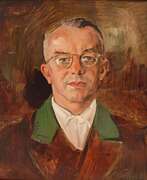

Peter Hirsch is a German painter, graphic artist and draftsman as a child private lessons in painting, apprenticeship as a lithographer, studied at the Munich Academy. He loaded exhibitions in the Munich Glass Palace and in the Kunstverein, ostracized as "degenerate" in Germany 1933-45 partly active in the USA, Canada, the Netherlands, Italy, England, France, Hungary and Switzerland, from 1944 temporarily relocated to the Schliersee, before 1930 -1969 lecturer at the Munich Adult Education Center.
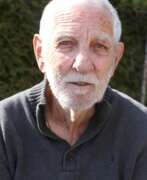

Elmar Kopp is an Austrian painter and sculptor, received artistic training from Toni Kirchmayr in Innsbruck. Despite losing his right hand in a work accident in 1949, he studied painting under Josef Dobrowsky and Herbert Boeckl, and sculpture under Fritz Wotruba at the Academy of Fine Arts in Vienna from 1951. Kopp completed his studies in 1954 and became a freelance artist in Imst. He created landscape, floral, and figurative paintings, as well as numerous public artworks such as sculptures, frescoes, sgraffiti, and mosaics. Kopp also provided designs for stained glass windows and tapestries woven by his wife, Midi. He traveled extensively throughout Europe, Africa, and Asia. In 1982, he was awarded the title of Professor by President Rudolf Kirchschläger.
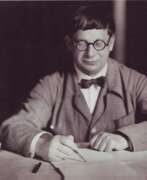

Hans Poelzig was a German architect, whose profound influence on art and culture was marked by his expressive and dramatic architectural style. His work, synonymous with the German Expressionist movement, forged a legacy of emotional and thought-provoking design that continues to resonate with art collectors and experts today.
Among Poelzig's most revered projects is the iconic I.G. Farben Building in Frankfurt, completed in 1931 and now part of Goethe University, a testament to his ability to design on a grand scale. His impact on architectural culture is also seen in the Grosses Schauspielhaus in Berlin, which stands as a paragon of expressionist architecture. This building, along with others like the Four Domes Pavilion in Wrocław, highlights Poelzig's penchant for theatrical and impactful design.
Poelzig's architectural narrative extended beyond the tangible; he conceptualized designs for the Palace of the Soviets and the League of Nations headquarters, which, despite remaining unbuilt, underscore the breadth of his vision. His academic roles, including director positions at the Breslau Art Academy and the Technical Academy in Berlin, allowed him to shape future architects and propagate his innovative design philosophy.
For those deeply invested in the realms of art and antiques, Poelzig’s creations are not merely structures but embodiments of a transformative era in architectural history. His buildings, some of which have earned the honor of being UNESCO World Heritage Sites, serve as a bridge between the past and present of architectural excellence.
To receive updates on new product sales and auction events related to Hans Poelzig, please sign up for our newsletter. This service is exclusively crafted for connoisseurs and professionals, offering timely information to enhance your collection and knowledge of historic art and architecture.


Ernst Matthias Schroffenegger was an Austrian painter. Ernst Schroffenegger studied mechanical engineering and electrical engineering and entered the service of the Austrian Federal Railways in 1923. In Innsbruck he received training in painting from Toni Kirchmayr and Max von Esterle and in fresco painting from Ernst Nepo. In 1943/44 he studied at the Académie de la Grande Chaumière in Paris with Othon Friesz. Schroffenegger created numerous murals, including for the Ruetz power station and the station buildings. At times he was on the board of directors of the Tiroler Künstlerschaft.
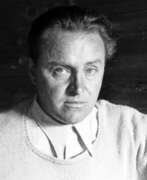

Alfons Walde was an Austrian expressionist painter and architect.
He studied architecture at the Higher Technical School in Vienna, but became interested in painting, found his muse in his native Kitzbühel Alps and became famous for his paintings of their snow-covered slopes and mountain huts. He was particularly fascinated by the dashing skiers of the time. Walde's popularity grew along with the popularity of the ski resort. Walde was also an active graphic artist and designed many posters.
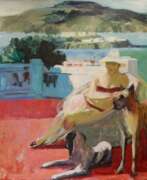

James Darrell Northrup Weeks was an American artist and an early member of the Bay Area Figurative Movement. Unlike many artists in the movement, Weeks was never known for painting in a non-representational style, instead using abstraction in the "ideas of painting."
